How generative AI is quietly distorting your brand message by Semrush Enterprise
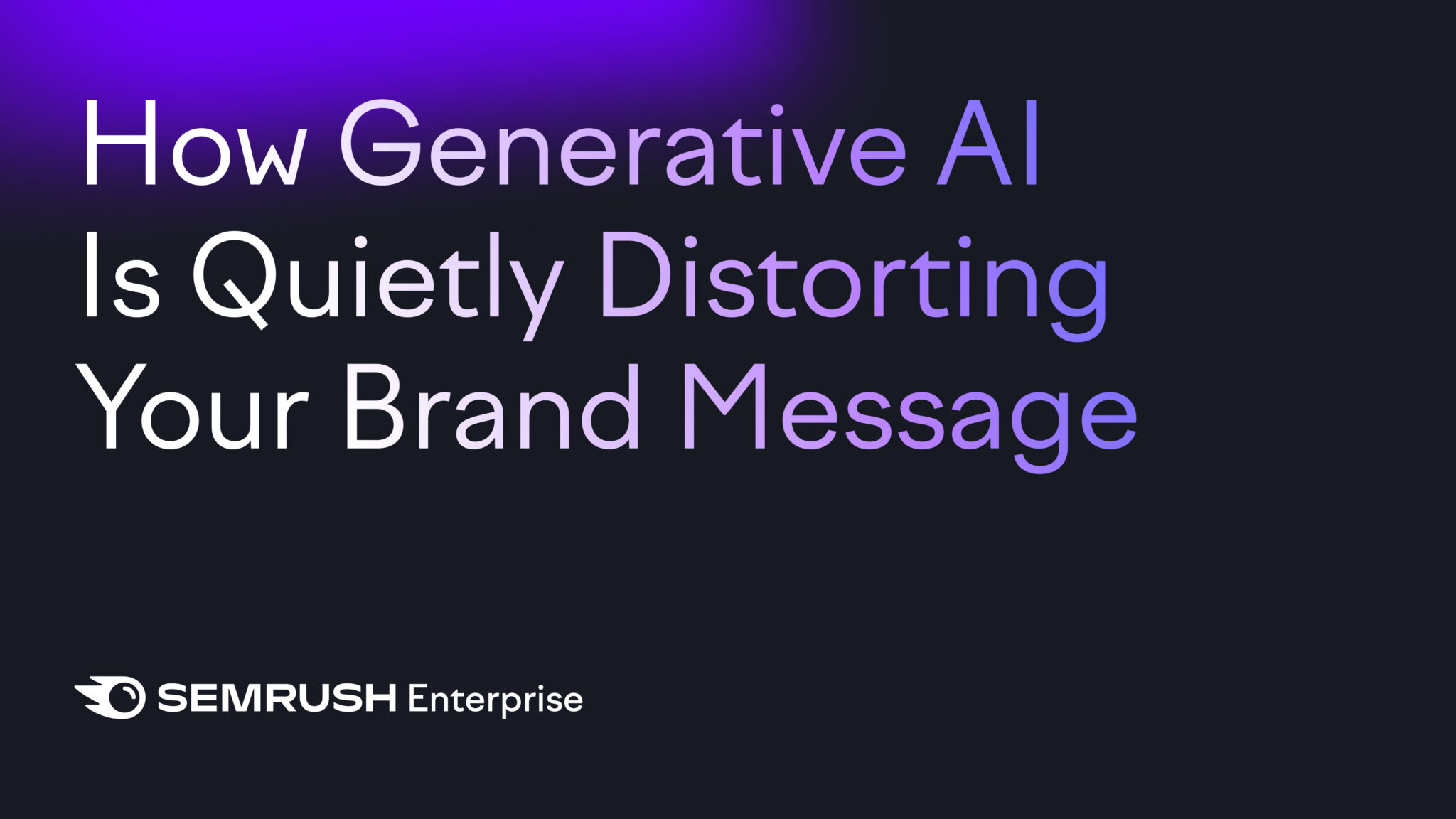

Your brand message is no longer entirely yours to control.
AI systems have become storytellers, shaping how consumers discover and understand your brand. Every customer review, social media post, news mention, and errant leaked internal document can feed AI models that generate responses about your company.
When these AI-generated narratives drift from your intended brand message, a phenomenon we can define as AI brand drift, the results can be devastating.
Your official brand voice, customer complaints, and leaked memos are LLM fuel. AI synthesizes everything into responses that millions of consumers encounter daily.
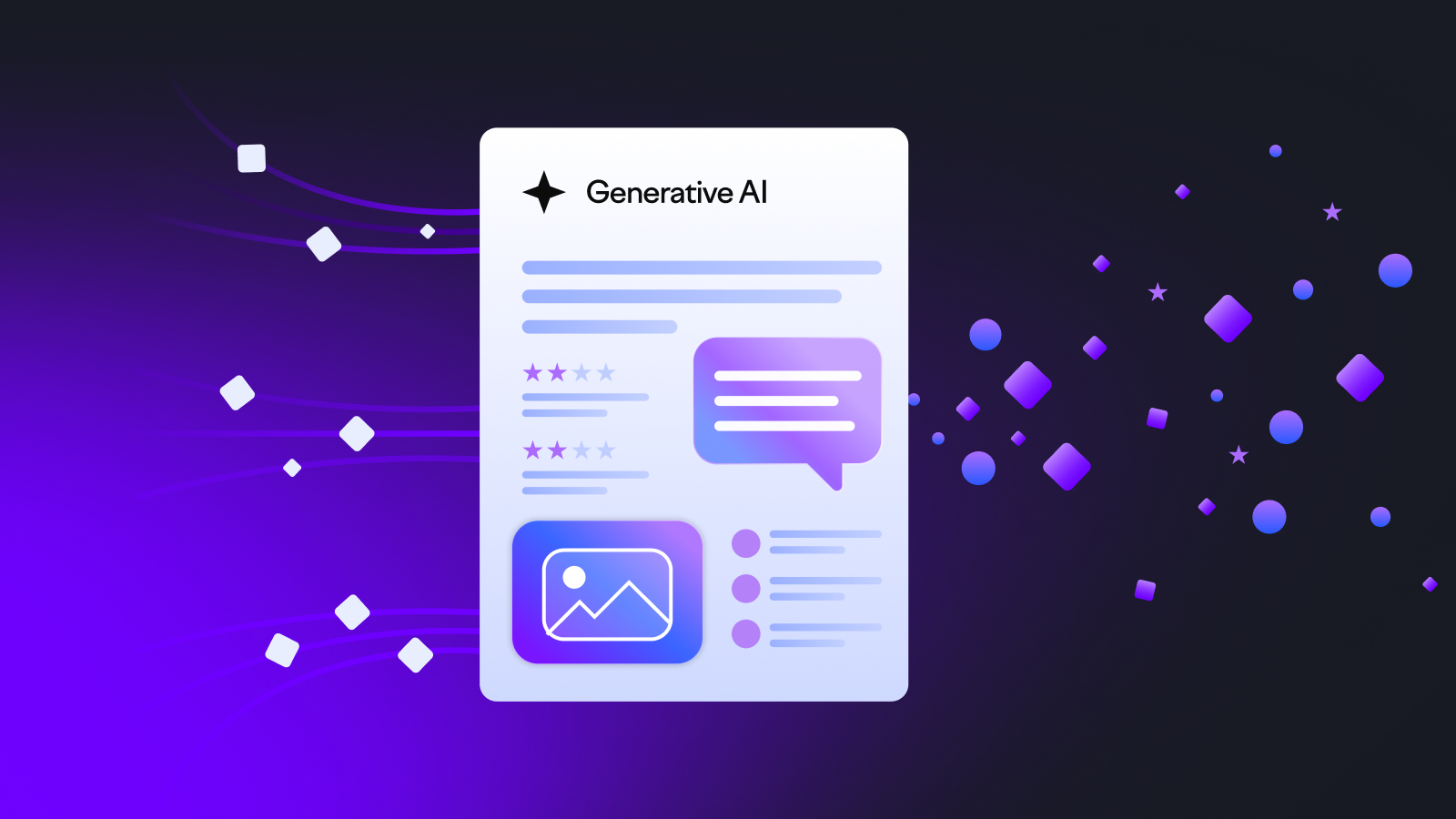
Your brand messaging competes with unfiltered customer sentiment and information that was never meant for public consumption. AI-driven misrepresentations can instantly reach global audiences through search results, chatbot interactions, and AI-powered recommendations. Mixed brand signals can reshape how AI systems describe your company for years to come.
This guide will show you how to identify AI brand drift before it damages your market position and provide actionable strategies for regaining control.
The complete brand spectrum: 4 layers you can’t afford to ignore
Large language models aggregate every available signal about your brand, turn around, and synthesize authoritative-sounding responses that consumers accept as fact. Companies confirm that phantom features proposed by ChatGPT cause support tickets, but are also considered part of the product roadmap.
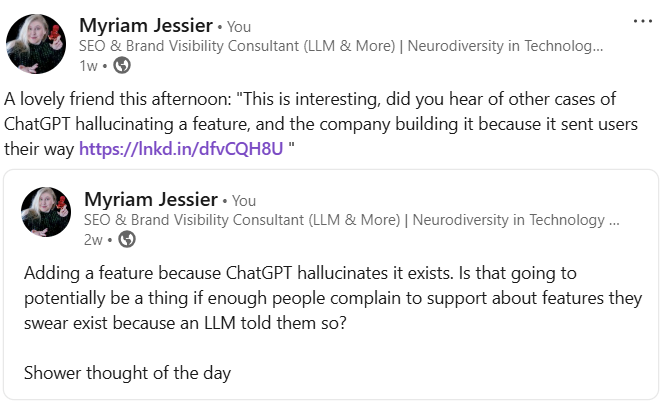
This is the case for the company Streamer.bot:
“We often have users joining our Discord and say ChatGPT told said xyz. Yes the tool can,however their instructions are wrong 90% of the time. We end up correcting their attempts to get it working how they want, still creates support tickets.”
Brand stewardship now requires managing four distinct but interconnected layers. Each layer feeds AI training data differently. Each carries different risk profiles. Ignore any layer, and AI systems will construct your brand narrative without your input.
The Brand Control Quadrant frames these layers:
| Layer | Description | AI Impact |
| Known Brand | Official assets: logos, slogans, press kits, brand guides. | Semantic anchors for AI; most controlled, but only the tip of the iceberg. |
| Latent Brand | User-generated content, community discourse, memes, cultural references. | Fuels AI’s understanding of brand relevance and relatability. |
| Shadow Brand | Internal docs, onboarding guides, old slide decks, partner enablement files—often not public. | The risk: LLMs can inject outdated or off-message info into AI summaries. |
| AI-Narrated Brand | How platforms like ChatGPT, Gemini, and Perplexity describe your brand to users. | Synthesis of all layers. Answers served as “truth” to the world. This leads to a high risk of misalignment and distortion. |
Key insight: AI reconstructs your brand from all accessible layers. AI co-authors brand narratives.
Here’s a concrete example: BNP Parisbas’ logo is contextualized by Perplexity.ai using a “Bird Logos Collection Vol.01” Pinterest board.
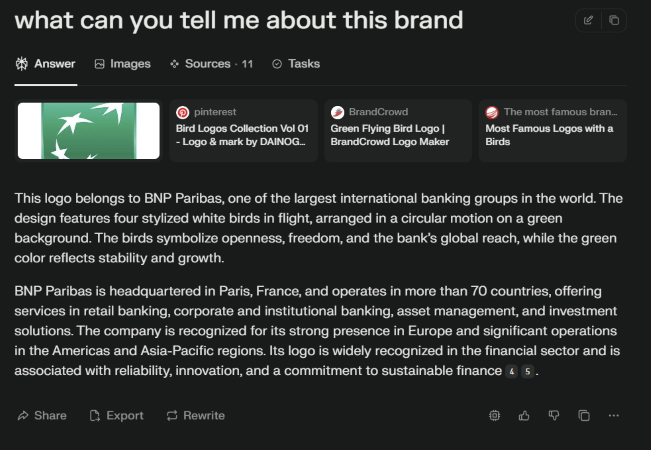
From technical flaw to brand crisis
“Semantic drift describes the phenomenon wherein generated text diverges from the subject matter designated by the prompt, resulting in a growing deterioration in relevance, coherence, or truthfulness.” – A., Hambro, E., Voita, E., & Cancedda, N. (2024). Know When To Stop: A Study of Semantic Drift in Text Generation.
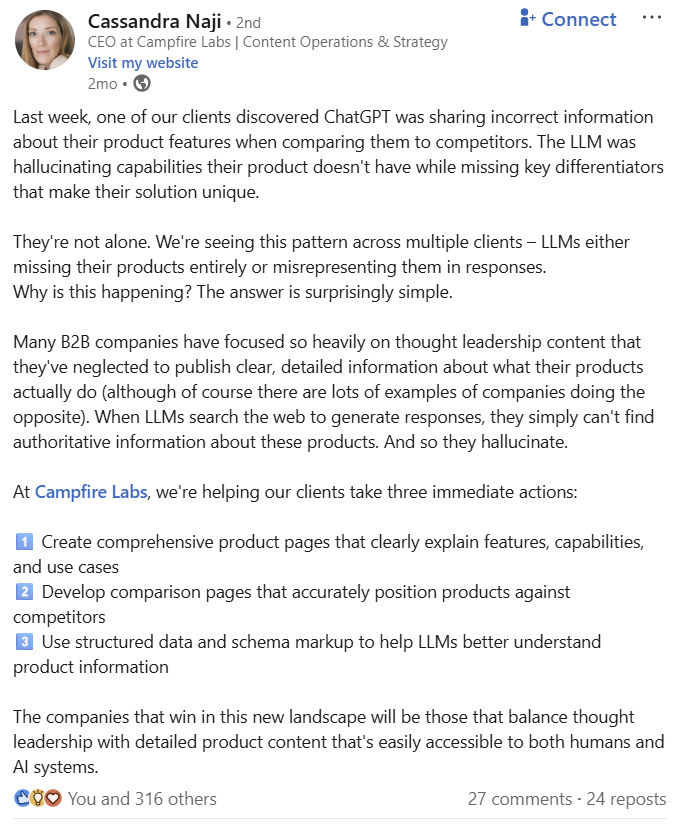
When AI-generated content gradually strays from your brand’s intended message, meaning, or facts as it unfolds, you know you are dealing with a brand drift crisis. This can take several forms:
- Factual drift: The model starts out as factual but introduces inaccuracies as the conversation progresses.
- Intent drift: Facts are retained, but the underlying intent or nuance is lost, leading to brand misrepresentation or confusion with competitors.
- Shadow brand drift: AI-powered search may surface outdated product specs, misquote leadership, or reveal elements meant for internal communication only.
Key insight: Even well-trained AI can quickly undermine brand clarity, consistency, and trust if not closely managed.
This can also create cybersecurity issues. Netcraft published a study concluding that 1 in 3 AI-generated login URLs could lead to phishing traps. Between fake features and dodgy login pages, monitoring is key!
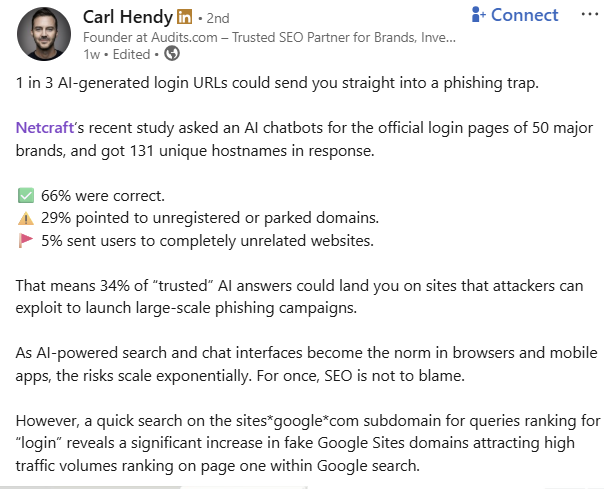
How AI brand drift unfolds
LLMs generate text sequentially, with each new word based on the prior context. There’s no “master plan” for the entire output, so drift is inherent.
Most factual or intent drift occurs early in the output, according to a 2024 study of semantic drift in text generation. Errors are compounded in multi-turn conversations: initial misunderstandings are amplified and rarely corrected without a context reset (starting a new conversation for example).
Marketers must be aware that they face critical vulnerabilities, identified by leading experts at Meta and Anthropic:
- Loss of coherence: This manifests as diminished clarity, disrupted logical progression, and a breakdown in self-consistency within the narrative.
- Loss of relevance: This occurs when content becomes saturated with irrelevant or repetitive information, diluting the intended message.
- Loss of truthfulness: This is characterized by the emergence of fabricated details or statements that diverge from established facts and world knowledge.
- Narrative collapse: When AI outputs are used as new training data, the original intent can morph entirely.
- Zero-click risk: With Google AI Overviews becoming the default in search, users may never see your official content. They would rely only on the AI’s synthesized, potentially drifted version.
AI-generated content sounds plausible and on-brand but could subtly distort your message, values, or positioning. This drift can erode brand equity, undermine consumer trust, and potentially introduce compliance risks.
The hidden driver of drift
The shadow brand is the sum of internal, proprietary, or outdated digital assets your organization has created but not intentionally exposed:
- Onboarding documents.
- Internal wikis.
- Old presentations.
- Partner enablement files.
- Recruitment PDFs.
- And any other information that is not meant for public consumption.
If these are accessible online (even buried), they are “trainable” by LLMs. If it’s online, it’s fair game for LLMs (even if you never meant it to be public).
Shadow assets are often off-message. Outdated or inconsistent materials can actively shape AI-generated answers, introducing narrative drift. Most teams do not track their shadow brand, leaving a major gap in their narrative defense.
From drift to distortion: The brand risk matrix
| Drift Type | Brand Risk | Example Scenario |
| Factual Drift | Compliance violations, misinformation, legal exposure, customer confusion. | AI lists outdated features as current, invents product capabilities, or misstates regulatory claims. |
| Intent Drift | Value misalignment, loss of trust, diluted brand purpose, reputational damage. | Sustainability message is reduced to a generic “green” platitude, or brand values are misrepresented. |
| Shadow Brand Drift | Narrative hijack, exposure of confidential or sensitive info, competitor leakage, internal miscommunication. | Old partner deck surfaces, referencing past alliances; internal docs or leadership quotes go public. |
| Latent Brand Drift | Meme-ification, tone mismatch, off-brand humor, loss of authority. | AI adopts community sarcasm or memes in official summaries, undermining professional tone. |
| Narrative Collapse | Erosion of brand story, loss of message control, amplification of errors. | AI-generated errors are repeated and amplified as they become new training data for future outputs. |
| Zero-Click Risk | Loss of audience touchpoint, diminished traffic to owned assets, lack of context for brand story. | AI Overviews in search engines present a drifted summary, so users never reach your official content. |
Regaining brand narrative control
You should audit and map all four brand layers:
- Known Brand: Ensure all official assets are up-to-date, accessible, and semantically clear. Create a “brand canon,” a centralized, authoritative source of facts, messaging, and positioning, optimized for AI consumption.
- Latent Brand: Monitor UGC, community forums, and cultural signals; use social listening to spot emerging themes.
- Shadow Brand: Conduct regular audits to identify and secure or update internal docs, old presentations, and semi-public files.
- AI-Narrated Brand: Track how AI platforms summarize and present your brand across search, chat, and discovery. Implement LLM observability along with methods to detect when AI-generated content diverges from brand intent.
Lead the AI brand narrative
Brand is no longer just what you say, it’s what AI (and your customers) says about you. In the generative search era, narrative control is a continuous, cross-functional discipline.
Marketing teams must actively manage all four layers, own the shadow brand, and measure semantic drift. Track how meaning and intent evolve in AI outputs in order to establish rapid responses to correct drifted narratives, both in AI and in the wild.
As Philip J. Armstrong, GTM Head of Insights & Analytics at Semrush, puts it, “Keeping an eye on brand drift protects your hard-earned brand reputation as consumers move to AI to evaluate products and services.”


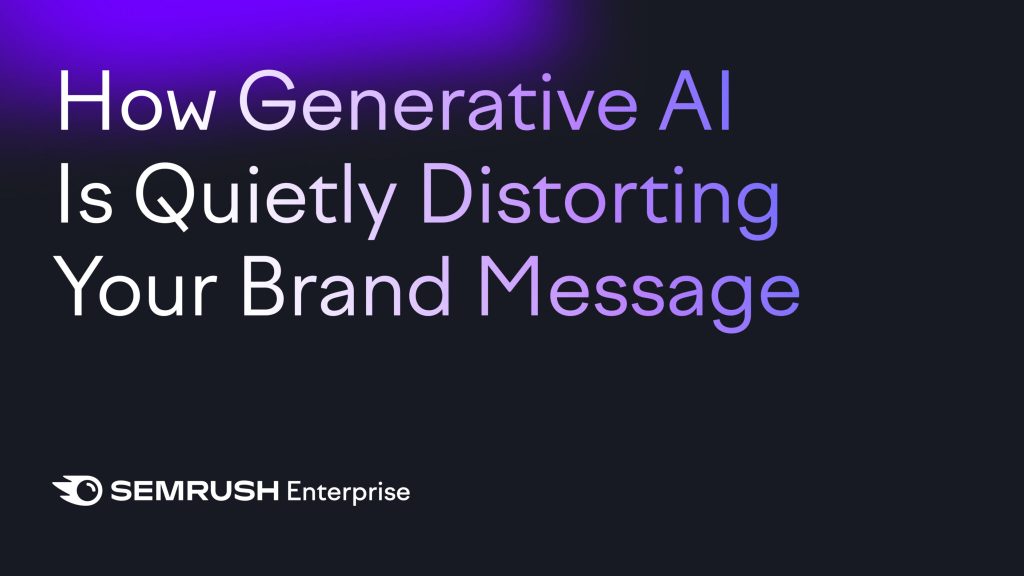




Recent Comments